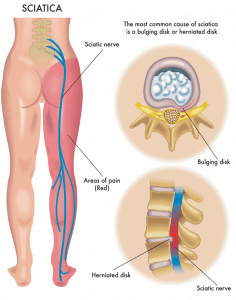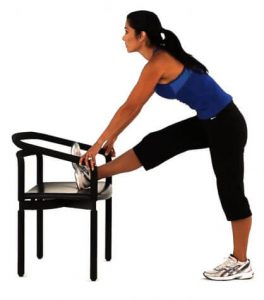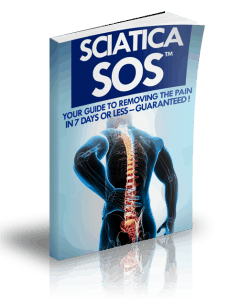Sciatica pain is a term that has been used widely to describe pain around the buttock and leg area.
But do you actually know what is sciatica pain? Do you know that it’s not just a light sprain? Do you know that it could be symptoms for a bigger underlying problem?
I hope I get your attention now. In this article, I’m going through with what is sciatica pain, what causes it and what can you do to treat it. Read on!
What Is Sciatica Pain?
 So what is sciatica pain? Sciatica pain (or just Sciatica) is the term used to describe pain resulting from irritation of the nerves surrounding the buttocks, legs and feet.
So what is sciatica pain? Sciatica pain (or just Sciatica) is the term used to describe pain resulting from irritation of the nerves surrounding the buttocks, legs and feet.
Contrary to common beliefs, sciatica pain is not a medical condition or disorder on its own; it’s a symptom of other medical conditions.
The sciatic nerve (more on that later on below) receives and sends out signals from the brain to these middle to lower body parts.
When the nerve is irritated or compressed, it will send a pain signal to the brain that is similar to leg cramps. The pain can be excruciating and makes it hard to walk or sit due to its intensity.
So you can kinda relate on why the pain is call sciatica pain – it’s because the most common nerve being irritated is the sciatic nerve.
It’s a sharp pain that shoots through your buttocks and legs. And trust me, it’s not something that you want to experience!
While sciatica pain is not constantly happening, it can attack at the most inopportune time, making it difficult to go on with normal lives.
Now that we’ve touched base on what is sciatica pain, it’s time to be acquainted with the very important sciatic nerve.
What Is The Sciatic Nerve?
Now let’s get on to the all-important sciatic nerve (the reason why it’s called “Sciatica Pain” in the first place).
The sciatic nerve (also called ischiadic nerve or ischiatic nerve) begins from the lower back to the lower leg through buttocks.
 As you can see, its a very long nerve and it’s very important to send & receive signals from the spinal cord to the entire lower body.
As you can see, its a very long nerve and it’s very important to send & receive signals from the spinal cord to the entire lower body.
Due to it’s location and length that is ingrained within vast muscles of the lower body, there’s a high chance that it can be irritated.
If you think about it, most of our movements depends on the lower body. While the upper body i.e hands and head also do a lot of work, the range of motion of it is still within the limit.
But that’s not the case with lower body.
Daily activities such as walking, sitting, standing, running, and others all require a huge degree of movement from the lower body.
And these activities have heavy impact the muscles of the lower body due to the range of motion and there’s higher possibility of doing it wrongly.
Have you ever heard of slipped disc?
It’s one of the most common type of injury on the lower spine. And this injury is usually caused by some daily activities such as lifting heavy objects, falling on your back or even aging of the spine!
And guess what, slipped disc is one of the main underlying root cause for sciatica pain. In fact, most sciatica root cause are from injury or trauma to the spine. In the next section, we’re going to see what kind of injury leads to sciatica pain.
What Causes Sciatica?
There are a number of potential causes for a compressed or irritated sciatic nerve. Below are the most common causes:
- Slipped disc: Also called herniated disc, slipped disc happens when the interior of the disc bulges more than it should either through injury (most common) or just because of wear and tear of the spine. This can lead to compression of the sciatic nerve (which is directly next to the spine disc, surprise!), resulting in pain and discomfort just by simply changing your positions. Slipped disc and sciatica often goes hand in hand together and is a real pain to deal with (trust me on this!)
- Spinal injury: If you injure your spine, or the muscles that support the spine, inflammation can press on the sciatic nerve.
- Spinal stenosis: Spinal stenosis is a nerve compression disorder which can make the passage holding the spinal cord can become narrowed – often due to large ligaments. This is a medical issue most commonly found in aging people and in response, this can cause compression on the sciatic nerve.
- Spondylolisthesis: It is a condition where a vertebra/spine disc moves more than it should and normally at the base of the spine (just picture one of the spine is offset from the others..) It can either be caused by injury or the spine could be defective from birth.
- Piriformis syndrome: As the sciatic nerve runs through the back of our legs, the condition of the muscles around it is an important factor. If the muscles is tightened, it can compress the sciatic nerve leading to sciatica pain.
 The amount of pain, loss of sensation or tingling can vary depending on how much the nerve has been compressed or irritated.
The amount of pain, loss of sensation or tingling can vary depending on how much the nerve has been compressed or irritated.
The location of the nerve compression can also affect where the pain radiates.
I’d like to note that in some cases, these injuries to the spine can be asymptomatic, that is it does not hurt and you don’t even know it exist.
Only after getting into some kind of injury it will suddenly becomes worse and you’ll start to know that you have it.
Treatment of these underlying root causes should be the number one priority for you and can only be done by a medical professional.
In my case, I’ve managed to arrest my slipped disc issue with the help of my chiropractor and physiotherapist. But then I still have the sciatica pain tagging along with me even after the slipped disc had been reduced to minimal.
There’s a lot of ways that we can do to treat sciatica pain which I’m going to share in the next section.
How is Sciatica Pain Treated?
As you have seen, sciatica pain can be caused by many reasons. Which is why for each cause of sciatica, we will require a specific treatment plan to effectively reduce compression on the sciatic nerve.
The best thing will be to treat the root cause (slipped disc, spinal stenosis, etc.). This is very important as these are critical issues and need to be treated fast before it get worse (as in disabled from waist down worse…).
But traditionally, treatment for sciatica pain usually involves pain-killing medications and resting. Even though this is effective at reducing pain, it only treats the symptom (sciatica pain) and not the root cause.
The pain will surely comes again and how long are you going to take the pain killers?
You can also treat sciatica using home treatments that you can do at home. Personally, I like this better because it’s more natural compared to taking drugs and give a fast relief as well.
 To treat the root cause and prevent sciatica pain from resurfacing, physiotherapy exercises is the way to go. Unlike pain-killing medication, these exercises treat the underlying problem (i.e nerve root pinching) but you’ve got to remember that only the right exercises should be performed based on the cause of sciatica.
To treat the root cause and prevent sciatica pain from resurfacing, physiotherapy exercises is the way to go. Unlike pain-killing medication, these exercises treat the underlying problem (i.e nerve root pinching) but you’ve got to remember that only the right exercises should be performed based on the cause of sciatica.
Do remember that if you have critical spine disorder, exercises can usually make it worse for you!
Doing the wrong exercises can worsen pain and increase the time taken for recovery. As someone that have been there, I strongly suggest to listen to your body when doing exercises (or any physical activities for the matter).
This involves starting lightly and stop if you feel any kind of pain or discomfort during the exercises.
Last but not least, simply tweaking you method of sleeping can give relief from sciatica pain.
Want To Learn More About Treating Sciatica? Get Sciatica SOS!
 If you would like to learn how to resolve sciatica pain in just seven days – without medication or expensive treatments – click here to visit Sciatica SOS.
If you would like to learn how to resolve sciatica pain in just seven days – without medication or expensive treatments – click here to visit Sciatica SOS.
It’s a complete holistic treatment program based on experts in the field of sciatica.
Thousands of people (including me!) have used it to get rid of sciatica in less than a week and it is backed by a paypal-verified 100% money back guarantee.
What I love most about Sciatica SOS is the fact that it uses an easy to do treatments instead of relying on doctors.
Most of the treatment options can be done at the comfort of your home and that is one of the awesome things about it.
Conclusion
Having sciatica pain is never easy. Imagine having little shots of pain through your lower body a few times a day – without a doubt that will surely impact your daily lives.
But most people overlooked about the fact that there is an underlying root cause for sciatica. These root causes, most often than not involves some form of injury to the spine, is very critical and need to be treated as soon as possible to stop it from becoming worse.
Once you’re already underway with its treatment, then you can start doing some scitica-centric treatments to stop the pain from disturbing your lives.
I hope this article on what is sciatica pain will be beneficial to you. You are most welcomed to contact me for any questions by commenting below.
Till next time!
Cheers!

Great article here! As someone that suffered from sciatica pain before, you’ve nailed the whole part very well. Cheers!
Hi Casey. Thanks for the compliment =)
I’d love to share my experience. Last year, I endured terrific pain from a narrowed spinal foramen – where the nerves exits the the spinal cord to run down the legs. I was referred to a Bio-kinetics therapist. She worked on strengthening my core muscle and addressed a few physical ‘bad habits’ I had developed over the years. I now walk more upright and engage my stomach muscles and buttocks at every opportunity. I am following a daily program of exercises – admittedly I would not have achieved the results without my dedication to doing these, but hell, I am a new person. That took only 2 months to achieve. I am over 70 and feels like I could conquer the world again.
Hi Marie. That’s great news! Without a doubt, most of our muscular & nerve pains can be attributed to some issues within our body and correct posture & exercises are about the best way (not to mention cost effective) to treat these issues.
If you don’t mind, perhaps you can share the types of exercises that you do daily for the benefit of the readers here =)